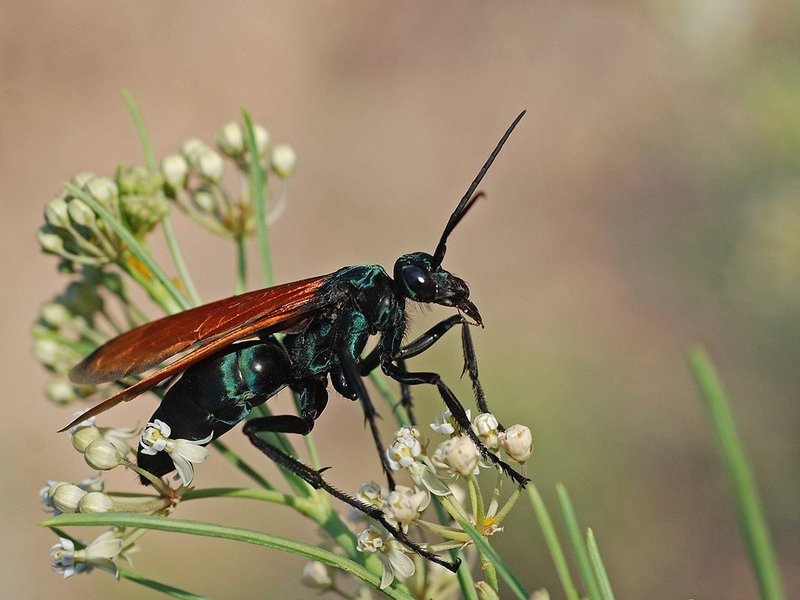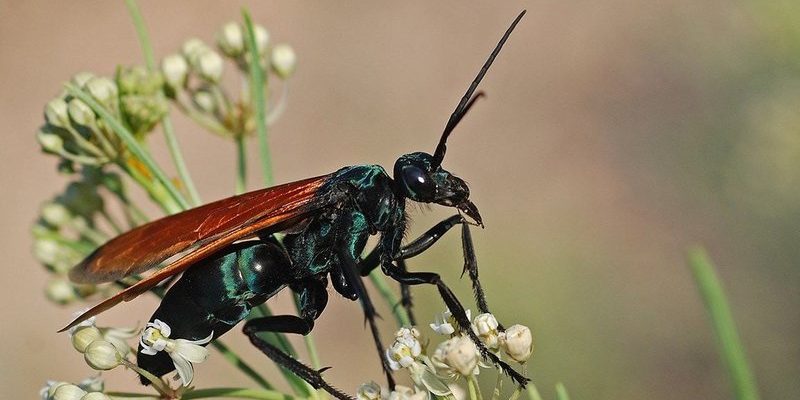
The Tarantula Hawk might sound like a character from an action movie, but it’s a real creature that deserves your attention. This oversized wasp is known for its incredible strength and daunting hunting methods. Picture this: a wasp so powerful that it can subdue a tarantula—a creature already feared for its size and speed. Intrigued? You should be. The Tarantula Hawk isn’t just your average insect; it’s a remarkable example of nature’s complexity and brutality.
When we think about the animal kingdom, we often marvel at the beauty and grace of creatures. But let’s not overlook the strategy and survival tactics of other species. The Tarantula Hawk combines striking appearances with an even more fascinating life cycle, making it a key player in its ecosystem. In this article, we’ll explore everything you need to know about the Tarantula Hawk, from its habits and habitat to its role in nature.
What is a Tarantula Hawk?
The Tarantula Hawk is actually a type of wasp, belonging to the family Pompilidae. What’s fascinating about these wasps is their unique hunting method. They are often found in warm climates and are particularly common in places like the southwestern United States, parts of South America, and the Caribbean. Despite their fearsome reputation, Tarantula Hawks are generally docile unless provoked, making them more interesting than threatening.
These wasps are easily recognizable, sporting vibrant colors that range from metallic blue to black and orange. Adult males typically measure about 1 to 2 inches long, while females can grow even larger. What sets them apart is their elongated bodies and large wings, which they use to fly with surprising agility. Although they have powerful stings—reputed to be among the most painful in the insect world—they are primarily focused on finding tarantulas for reproduction.
Physical Characteristics
One of the most striking features of the Tarantula Hawk is its appearance. With their large, captivating wings and colorful exoskeletons, they can easily catch your eye. The females are especially notable for their larger size compared to males. Their wingspan can reach up to 3 inches, allowing them to maneuver gracefully through their environment.
The body of the Tarantula Hawk is equipped with strong mandibles, which they use to effectively subdue prey. Their legs are long and powerful, designed to grasp onto both prey and surfaces. When you see one buzzing around, you’ll notice how quickly they can dart from flower to flower, searching for nectar or tarantulas to hunt.
Habitat and Distribution
Tarantula Hawks thrive in diverse habitats, primarily in warm, arid regions. They prefer areas with plenty of sun, so you’ll often find them in deserts, scrublands, and forest edges. Their range extends from the southern United States to Central and South America, where they can encounter various tarantula species.
While they are capable of living in somewhat cooler climates, they generally favor environments that are dry and have ample vegetation. This allows them to find both food and shelter. It’s interesting to note that the availability of tarantulas heavily influences their distribution, as each Tarantula Hawk species often specializes in hunting a specific type of tarantula.
Life Cycle and Reproduction
The life cycle of the Tarantula Hawk is both fascinating and brutal. The female hunts down a tarantula, paralyzing it with her sting—a process that can take some time. After the tarantula is incapacitated, she lays her eggs inside the spider’s body. As the eggs hatch, the larvae feed on the still-living tarantula, which keeps the host fresh for as long as possible. Nature can be ruthless, and this method certainly reflects that.
Once the larvae mature, they emerge as mature wasps. This life cycle, known as parasitoidism, is a remarkable strategy that ensures the young have a constant food supply. It may sound cruel, but it’s a vital part of maintaining the balance of the ecosystem. Without these actions, the population of tarantulas could grow unchecked, disrupting the local food chain.
Diet and Hunting Behavior
The primary diet of the Tarantula Hawk consists of tarantulas, but adult wasps also consume nectar. Their ability to hunt and overpower tarantulas is nothing short of impressive. Female Tarantula Hawks use their powerful stings to paralyze spiders, rendering them unable to escape. You might be thinking, “Why tarantulas?” The answer lies in the size and availability of these spiders, which serve as excellent hosts for their young.
During the hunt, the female will use her keen sense of smell to locate tarantulas and engage them. After successfully bringing down a tarantula, she drags it back to her nesting site. Interestingly, some species of Tarantula Hawks have been observed performing a “dance” before delivering the final blow. This behavior seems to be a way of ensuring the spider is completely subdued before laying eggs.
Table of Interesting Facts
| Common Name: | Tarantula Hawk |
| Scientific Family: | Pompilidae |
| Size: | 1 to 2 inches long; females can be larger |
| Habitat: | Warm, arid regions, deserts, and forest edges |
| Diet: | Tarantulas and nectar |
| Lifespan: | Approximately 1 year |
| Sting Pain Level: | Ranked among the most painful stings |
Role in the Ecosystem
The Tarantula Hawk plays a crucial role in its ecosystem, primarily through its predatory relationship with tarantulas. By keeping tarantula populations in check, these wasps help maintain a balance within their habitats. This is particularly important in areas where tarantulas can become abundant and potentially disrupt other species.
Moreover, as pollinators, adult Tarantula Hawks contribute to the growth of various flowers and plants. They feed on nectar, transferring pollen from one bloom to another in the process. This dual role as a predator and pollinator highlights their importance in maintaining biodiversity.
Tarantula Hawk Sting: Pain and Effects
If you’ve ever heard about the infamous sting of the Tarantula Hawk, you’d know it’s not something to take lightly. The sting is incredibly painful and has been rated high on the Schmidt Sting Pain Index. Although their sting can feel like a hot nail being driven into your flesh, the pain is usually temporary, lasting around 5 to 10 minutes.
Despite the intense pain, the sting is not lethal to humans and doesn’t typically cause serious health issues unless you have allergies. This means you can admire these fascinating creatures from a distance without fear—just respect their space and marvel at their incredible abilities. Remember, they only sting when they feel threatened!
Conservation Status
Currently, Tarantula Hawks are not considered endangered, and many species thrive in their natural habitats. Their populations are stable, thanks in part to the adaptability of both the wasps and their tarantula prey. However, like many insects, they face threats from habitat loss and climate change, which can affect their ecosystems. Conservation efforts that protect natural habitats can play a significant role in ensuring these wasps continue to thrive.
Protecting the environments where Tarantula Hawks and tarantulas live is crucial. This means preserving the deserts, scrublands, and forests they depend on. By maintaining these ecosystems, we not only protect the Tarantula Hawk but also countless other species that share their habitat.
FAQ
Are Tarantula Hawks dangerous to humans?
While Tarantula Hawks have a fearsome reputation due to their painful stings, they are not aggressive towards humans. They typically only sting if provoked, so it’s best to observe them from a distance. If you do get stung, the pain is intense but usually brief and resolves without any serious complications.
Where can I find Tarantula Hawks?
Tarantula Hawks are found in warm and arid regions, particularly in the southwestern United States, Central America, and parts of South America. They prefer environments like deserts and scrublands where they can easily locate tarantulas. Observing them in their natural habitat can be a thrilling experience!
What do Tarantula Hawks eat besides tarantulas?
Aside from tarantulas, adult Tarantula Hawks also feed on nectar from flowers. This diet helps them sustain their energy as they hunt for tarantulas and contributes to pollination in their ecosystems. While their larvae exclusively feed on tarantulas, adult wasps have a broader diet that supports their survival.
How do Tarantula Hawks find their prey?
Tarantula Hawks rely primarily on their keen sense of smell to locate tarantulas. They can detect the presence of a spider from a distance, which guides their hunting efforts. Once they find a tarantula, they engage it and use their powerful sting to paralyze the spider before dragging it back to their nest.
Are all Tarantula Hawks the same species?
No, there are several species of Tarantula Hawks, each with distinct characteristics and behaviors. While they all share the common hunting method of targeting tarantulas, some species may specialize in different types of tarantulas or have unique adaptations to their environments. Each species plays a role in maintaining the balance of its own ecosystem.
How painful is a Tarantula Hawk sting compared to other stings?
The sting of a Tarantula Hawk is often described as one of the most painful insect stings. It ranks high on the Schmidt Sting Pain Index, often compared to the pain of a hot nail being driven into the flesh. However, it’s important to note that the pain is temporary and subsides within a short time. For most people, it won’t lead to serious medical issues unless they have an allergy.
Can Tarantula Hawks be kept as pets?
Keeping Tarantula Hawks as pets is generally not recommended. They play a specific role in nature, and their needs can be difficult to meet in captivity. Additionally, due to their aggressive hunting practices and painful sting, they may not be suitable for everyone. It’s best to appreciate them in their natural habitat rather than attempting to domesticate them.
Do Tarantula Hawks have any natural predators?
Yes, like many species, Tarantula Hawks are not without their enemies. Birds, such as mockingbirds, are known to prey on them. Additionally, other insects may also pose threats, especially to larvae. Despite these threats, Tarantula Hawks have evolved well to their environment and generally maintain stable populations.
What time of year are Tarantula Hawks most active?
Tarantula Hawks are typically most active during warm months, particularly in late summer and early fall. This activity coincides with the breeding season for both wasps and tarantulas. During this time, you’re more likely to see them hunting and engaging in their fascinating behaviors. Observing them during these months can provide great insights into their ecology.
Can Tarantula Hawks be found in my area?
To determine if Tarantula Hawks inhabit your area, consider the climate and local ecosystem. If you live in a warm, arid region of the United States or in parts of Central or South America, there’s a chance they may be nearby. Observing the presence of tarantulas can also be an indicator; where there are tarantulas, Tarantula Hawks are likely to follow!

